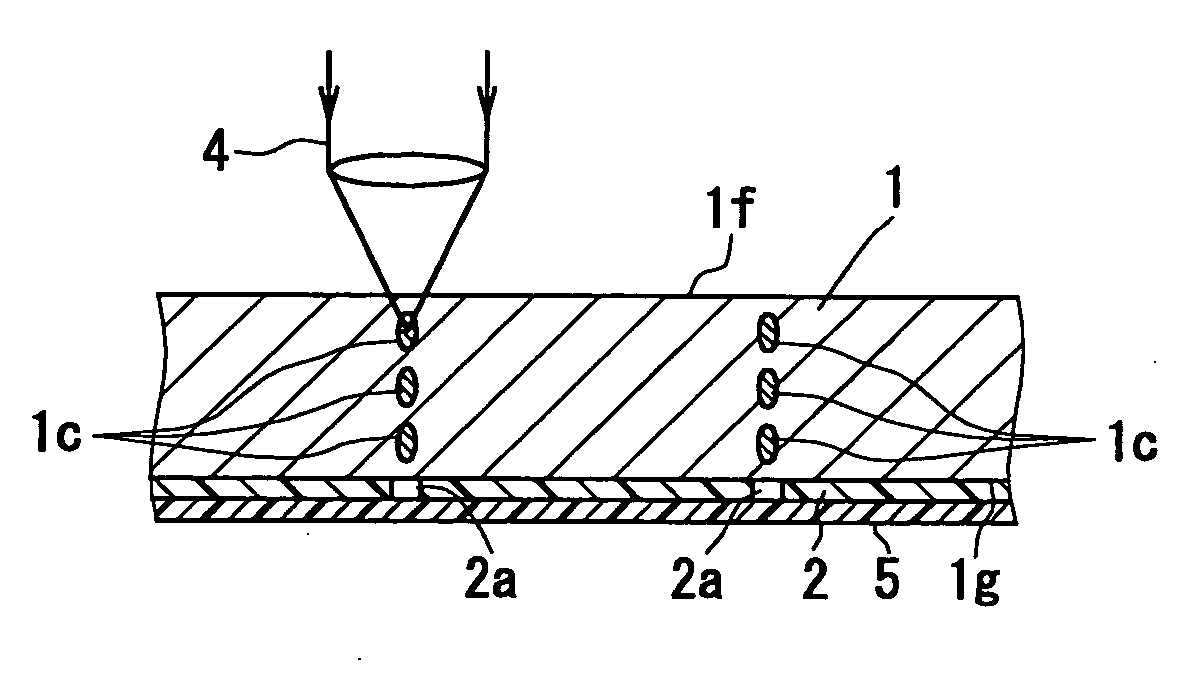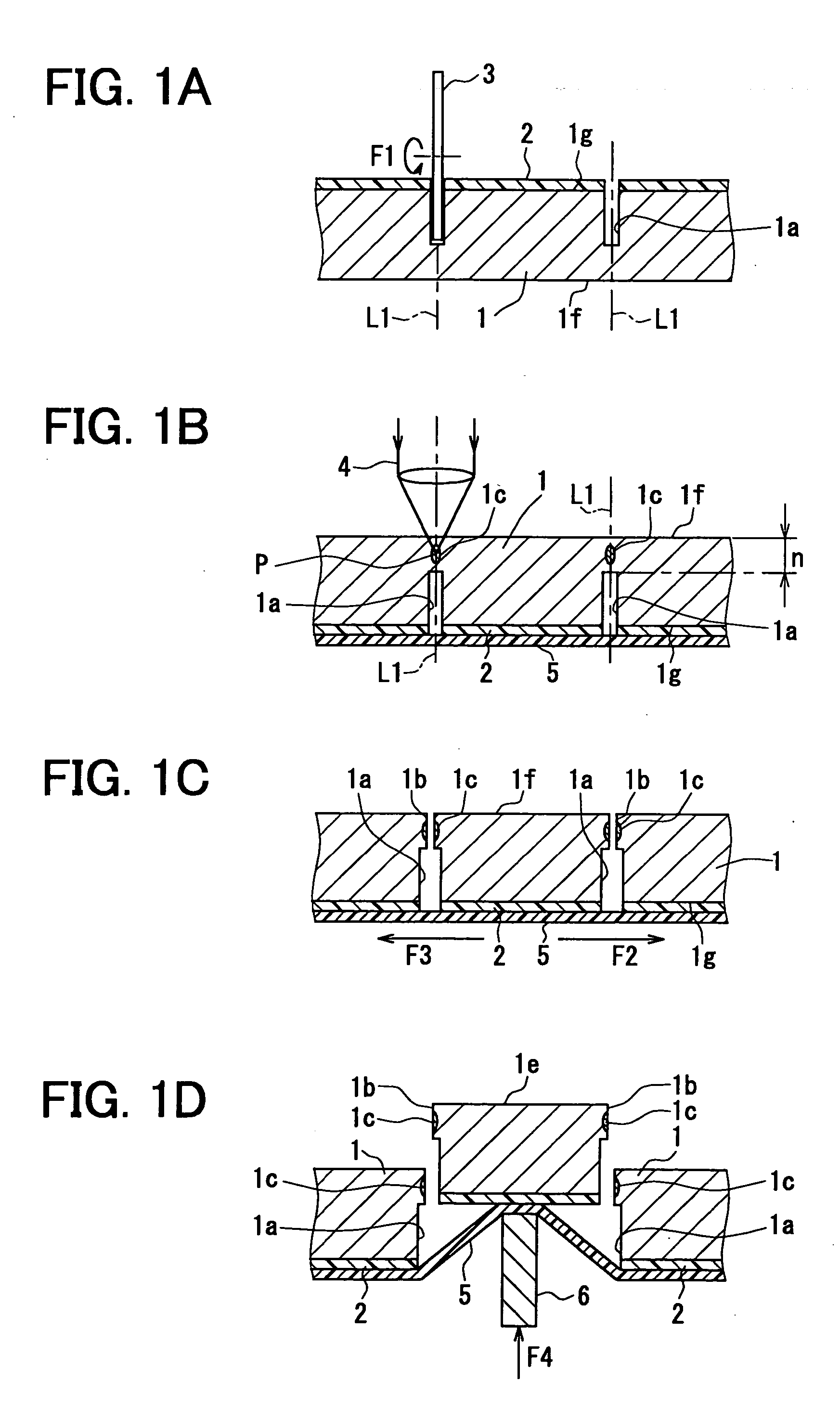Method for separating semiconductor substrate
a technology of semiconductor substrate and separation method, which is applied in the direction of manufacturing tools, welding/soldering/cutting articles, solid-state devices, etc., can solve the problems of substrate method, loss of cutting portion, and loss of blade width, so as to prevent the loss of substrate, prevent the defective implementation of semiconductor chips, and reduce the force required for separation
- Summary
- Abstract
- Description
- Claims
- Application Information
AI Technical Summary
Benefits of technology
Problems solved by technology
Method used
Image
Examples
first embodiment
[0022]FIGS. 1A to 1D show cross-sectional views of a separation process of a semiconductor substrate in a first embodiment of the present invention.
[0023] The process in the first embodiment is further detailed in the following steps. That is, in the step shown in FIG. 1A, the semiconductor substrate 1 having a DAF 2 adhered on a reverse side 1g is diced along a separation line L1 by a diamond blade 3 that rotates in a high-speed rotation in a direction indicated by a circular arrow F1. The dicing blade reaches to a depth in the substrate 1. Each of the separation lines L1 is formed in this manner. A cut 1a is formed in the semiconductor substrate 1 along the separation line L1.
[0024] Then, in the step shown in FIG. 1B, a dicing film is adhered on a reverse side (implementation side) of the DAF 2. The semiconductor substrate 1 is flipped to receive a laser beam 4 irradiated from a surface 1f side to have a focusing point P on an extension of the cut 1a in the substrate. The focusi...
second embodiment
[0032]FIG. 2A to 2D show cross-sectional views of a separation process of the semiconductor substrate in a second embodiment. The separation method described in the second embodiment does not use the diamond blade for separation. Like parts have like numbers as used in the first embodiment, and descriptions of like parts are omitted.
[0033] In the process shown in FIG. 2A, the DAF 2 is meltingly separated by a laser beam 7 having the focusing point put on the DAF 2 along the separation line L1 irradiated from the reverse side 1g. The intensity of the laser beam 7 is strong enough to melt and separated the DAF 2.
[0034] In the process shown in FIG. 2B, the dicing film 5 is adhered on the reverse side (implementation side) of the DAF 2. Then, the semiconductor substrate 1 is flipped to have the laser beam 4 from an upper side of the substrate 1. The focusing point P of the laser beam 4 is aimed at a bottom of the substrate to form the modified area 1c along the separation line L1 in t...
third embodiment
[0039]FIGS. 3A to 3D show cross-sectional views of a separation process of the semiconductor substrate in a third embodiment. In this embodiment, the DAF 2 is separated by a formation of the modified area with the laser beam from the surface of the semiconductor substrate. Like parts have like numbers as used in the second embodiment, and descriptions of like parts are omitted.
[0040] In the process shown in FIG. 3A, the dicing film 5 is adhered on the DAF 2. Then, the laser beam 7 is used to meltingly separate the semiconductor substrate 1. The laser beam 7 is irradiated from the surface 1f along the separation line L1 with the focusing point P aligned on the DAF 2. Each of the separation lines L1 on the DAF 2 is separated in this manner.
[0041] In the process shown in FIG. 3B to 3D, the semiconductor chip 1e is picked up by separating the semiconductor substrate 1 along the separation line L1 in the same process as described in the second embodiment shown in FIGS. 2B to 2D.
[0042]...
PUM
| Property | Measurement | Unit |
|---|---|---|
| wavelength | aaaaa | aaaaa |
| semiconductor | aaaaa | aaaaa |
| yield rate | aaaaa | aaaaa |
Abstract
Description
Claims
Application Information
 Login to View More
Login to View More - R&D
- Intellectual Property
- Life Sciences
- Materials
- Tech Scout
- Unparalleled Data Quality
- Higher Quality Content
- 60% Fewer Hallucinations
Browse by: Latest US Patents, China's latest patents, Technical Efficacy Thesaurus, Application Domain, Technology Topic, Popular Technical Reports.
© 2025 PatSnap. All rights reserved.Legal|Privacy policy|Modern Slavery Act Transparency Statement|Sitemap|About US| Contact US: help@patsnap.com



